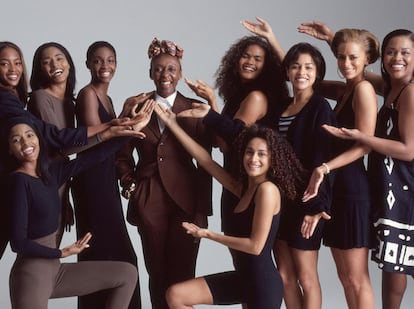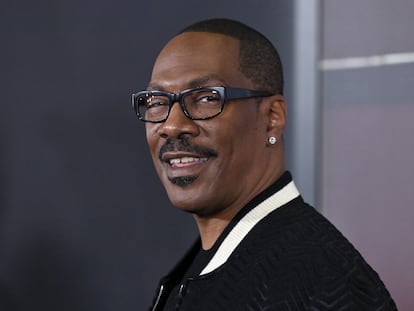Bethann Hardison: mentor to Naomi Campbell and Iman who brought diversity to the catwalk
The model and agent was a pioneer in the fight for equality. In the documentary ‘Invisible Beauty,’ she points out the causes of uniformity in fashion and beauty

Naomi Campbell and Iman call Bethann Hardison “Ma” because she is like a second mother to them. She didn’t discover the models or even represent them through her modeling agency; she just protected them, took care of them, and helped them as they faced hatred, rejection and racism in the fashion world. “I met her when I was 15; [I had] just arrived in New York, and I remember saying to her: ‘I don’t know whether I want you as an agent or as a friend for life.’ I chose the latter,” Campbell recalls in the documentary Invisible Beauty, which premiered at the Sundance Film Festival. The film tells the life story of model, agent and activist Bethann Hardison.
“She’s the godmother of fashion,” Tracee Ellis Ross says early in the film. “Whether people know it or not, she has changed the way we define beauty.” Indeed, Hardison doesn’t like the word beauty at all. She is uncomfortable with the concept, which continues to represent the standards and boundaries she has been fighting since she started out as a model in the late 1960s, a cause she continued to pursue as an agent for other models throughout the 1980s and 1990s.

Hardison wrote and directed the documentary herself. She tells her own story through archival footage and on-camera interviews with herself and her friends in the fashion and entertainment industry, including Willi Smith, Campbell, Iman, Zendaya, Bruce Weber, Fran Lebowitz, Whoopi Goldberg and Pat Cleveland. The film serves as the audiovisual part of a written memoir Hardison is completing. “I have to tell my life story, I owe it to the community,” she says in her New York apartment. We must “look back to move forward,” she insists. At 80 years old, she has no intention of slowing down; she is convinced that her activism against discrimination in pursuit of equality is even more necessary now than during her heyday three decades ago. “We have come a long way today, but we have advanced so much that I’m afraid we’ll do a 180º turn and go backwards,” she says. Hardison’s concern is justified because she’s already experienced it.
Born in Bedford-Stuyvesant, a black neighborhood in Brooklyn, to a Muslim “and intellectual” father and a “dancer and socialite” mother, Hardison was sent to an all-white high school in another part of New York. Far from a traumatic experience, she discovered that she could stand out there: “I was the first black cheerleader, the first black athlete...” It didn’t take her long to enter the hip beatnik Manhattan scene of the 1960s. Hardison was discovered by African American designer Willi Smith, an important name in the industry. She went with Smith and a group of models, both black and white, to the elite Versailles fashion show. White European royalty, led by Princess Grace of Monaco, enthusiastically applauded Hardison.
She returned to the United States a star. “That seemed impossible for a black woman with an almost androgynous look,” says photographer Bruce Weber. “She didn’t look like anybody [else].” According to writer Fran Lebowitz, Hardison was especially distinguishable from the whole glamorous, partygoing New York set in the 1970s “because she was the only one who had a son…We’d be at Studio 54, and Bethann would say, ‘I’m leaving; I have to take care of Kadeem.’”
Motherhood led Hardison to abandon her career as a globetrotting supermodel. She decided to become an agent, discovering new talent and representing other models. From the beginning, her agency stood out for “having personalities” and included models of all origins, races and profiles: Farida, Bonnie Berman, Veronica Webb, Katoucha, Nick Kamen, Ariane, Roshumba and her biggest star, Tyson Beckford, who was the first black model to sign exclusively with a major fashion brand, Ralph Lauren.
Representing models of all backgrounds and races, Hardison experienced inequality firsthand. “A black model can charge $700 for a shoot, while a white model can be paid $3,500 for the same job,” she said at a press conference of the Black Girls Coalition, which she founded in 1988 and presented alongside Campbell and Iman. Denouncing the fashion and beauty industry directly, she was able to increase the presence of other beauties in campaigns and on the catwalk over the past decade.

Feeling that she had fulfilled her role and tired of the industry, in 1996, she retired, closed the agency and went to Mexico. But without her in the fight, the fashion world took little time to reverse its progress. The documentary explains it as follows: the fall of the Berlin Wall led to a boom in Russian beauty. First, Miuccia Prada, followed by Calvin Klein and then the rest of the brands, began to hire only “very young, ultra-thin, white” models. “No blacks, no ethnics” was a guideline given to modeling agencies in writing. “Diversity had been exchanged for uniformity,” says Hardison, who took four years to react and return to the frontlines of activism. She held a massive press conference and issued a manifesto naming names and demanding accountability.
Liya Kebbede, Campbell, Iman, Veronica Webb, Tyra Banks, André Leon Talley… They all joined Hardison. As did many others. In response, Franca Sozzani, the editor of Vogue Italia produced an issue specifically dedicated to black talent and beauty. The issue sold out and had to be reprinted in Italy, Germany, the USA and the UK; it was an unparalleled success.
Today, Hardison celebrates all this progress. She also revels in the fact that she is now experiencing a new golden age with recognition by her contemporaries and younger generations alike. “Without her, I would not have had the opportunities I’ve had in this job I love. It’s as simple as that,” says Zendaya. But you have to keep going. “I don’t see the end,” Hardison says. “I always say that I’m not helping black people; I’m trying to educate and help white people.”
Sign up for our weekly newsletter to get more English-language news coverage from EL PAÍS USA Edition
Tu suscripción se está usando en otro dispositivo
¿Quieres añadir otro usuario a tu suscripción?
Si continúas leyendo en este dispositivo, no se podrá leer en el otro.
FlechaTu suscripción se está usando en otro dispositivo y solo puedes acceder a EL PAÍS desde un dispositivo a la vez.
Si quieres compartir tu cuenta, cambia tu suscripción a la modalidad Premium, así podrás añadir otro usuario. Cada uno accederá con su propia cuenta de email, lo que os permitirá personalizar vuestra experiencia en EL PAÍS.
¿Tienes una suscripción de empresa? Accede aquí para contratar más cuentas.
En el caso de no saber quién está usando tu cuenta, te recomendamos cambiar tu contraseña aquí.
Si decides continuar compartiendo tu cuenta, este mensaje se mostrará en tu dispositivo y en el de la otra persona que está usando tu cuenta de forma indefinida, afectando a tu experiencia de lectura. Puedes consultar aquí los términos y condiciones de la suscripción digital.
More information
Archived In
Últimas noticias
Welcome to the post-religion era: The idea of Christianity as the absolute truth has become obsolete
‘I thought you would like it’: The risky sexual practice popularized by TV shows and TikTok
The digitalization of tourism: ‘They promise experiences and gave us the worst possible one’
Mexican peso defies uncertainty with forecasts of a new period of stability in 2026
Most viewed
- Sinaloa Cartel war is taking its toll on Los Chapitos
- Reinhard Genzel, Nobel laureate in physics: ‘One-minute videos will never give you the truth’
- Oona Chaplin: ‘I told James Cameron that I was living in a treehouse and starting a permaculture project with a friend’
- Why the price of coffee has skyrocketed: from Brazilian plantations to specialty coffee houses
- Silver prices are going crazy: This is what’s fueling the rally










































